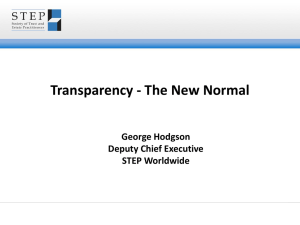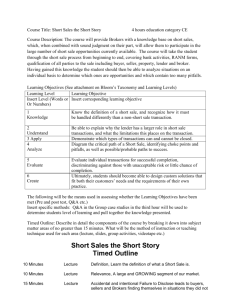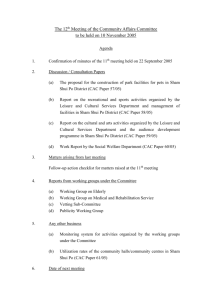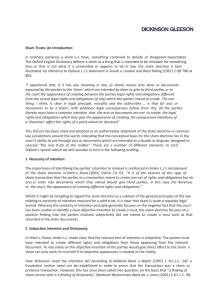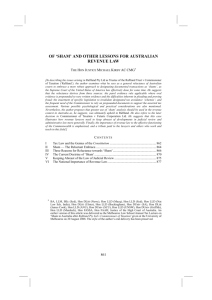Printable Version of this post
advertisement
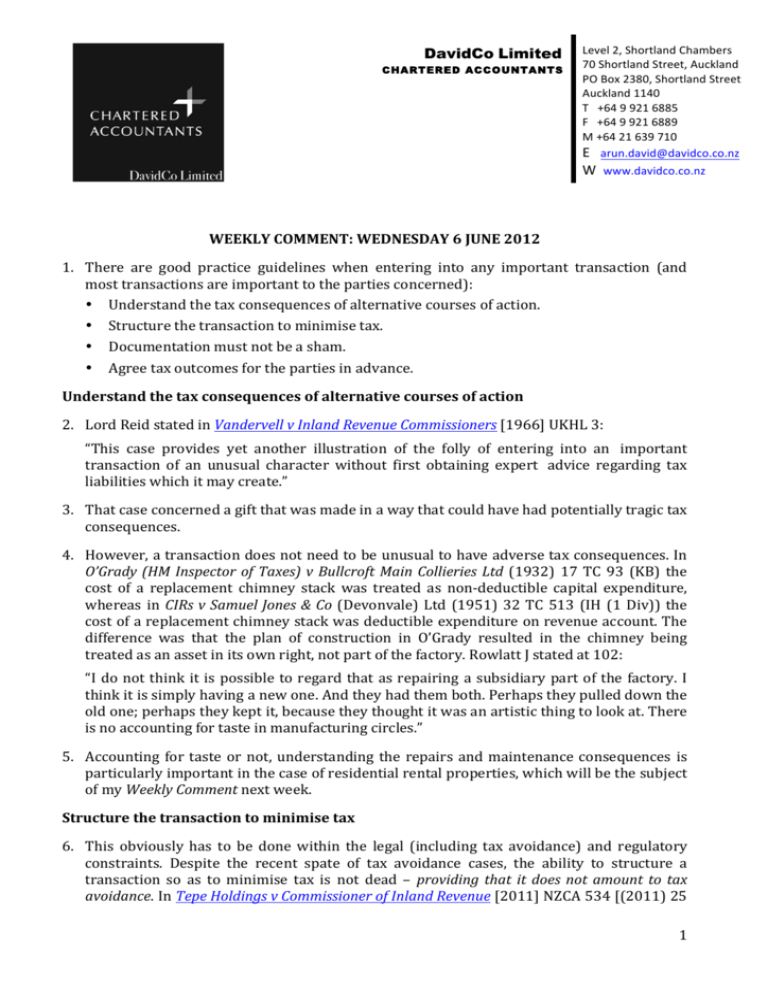
DavidCo Limited CHARTERED ACCOUNTANTS Level 2, Shortland Chambers 70 Shortland Street, Auckland PO Box 2380, Shortland Street Auckland 1140 T +64 9 921 6885 F +64 9 921 6889 M +64 21 639 710 E arun.david@davidco.co.nz W www.davidco.co.nz WEEKLY COMMENT: WEDNESDAY 6 JUNE 2012 1. There are good practice guidelines when entering into any important transaction (and most transactions are important to the parties concerned): • Understand the tax consequences of alternative courses of action. • Structure the transaction to minimise tax. • Documentation must not be a sham. • Agree tax outcomes for the parties in advance. Understand the tax consequences of alternative courses of action 2. Lord Reid stated in Vandervell v Inland Revenue Commissioners [1966] UKHL 3: “This case provides yet another illustration of the folly of entering into an important transaction of an unusual character without first obtaining expert advice regarding tax liabilities which it may create.” 3. That case concerned a gift that was made in a way that could have had potentially tragic tax consequences. 4. However, a transaction does not need to be unusual to have adverse tax consequences. In O’Grady (HM Inspector of Taxes) v Bullcroft Main Collieries Ltd (1932) 17 TC 93 (KB) the cost of a replacement chimney stack was treated as non-­‐deductible capital expenditure, whereas in CIRs v Samuel Jones & Co (Devonvale) Ltd (1951) 32 TC 513 (IH (1 Div)) the cost of a replacement chimney stack was deductible expenditure on revenue account. The difference was that the plan of construction in O’Grady resulted in the chimney being treated as an asset in its own right, not part of the factory. Rowlatt J stated at 102: “I do not think it is possible to regard that as repairing a subsidiary part of the factory. I think it is simply having a new one. And they had them both. Perhaps they pulled down the old one; perhaps they kept it, because they thought it was an artistic thing to look at. There is no accounting for taste in manufacturing circles.” 5. Accounting for taste or not, understanding the repairs and maintenance consequences is particularly important in the case of residential rental properties, which will be the subject of my Weekly Comment next week. Structure the transaction to minimise tax 6. This obviously has to be done within the legal (including tax avoidance) and regulatory constraints. Despite the recent spate of tax avoidance cases, the ability to structure a transaction so as to minimise tax is not dead – providing that it does not amount to tax avoidance. In Tepe Holdings v Commissioner of Inland Revenue [2011] NZCA 534 [(2011) 25 1 DAVIDCO LIMITED Weekly Comment 6 June 2012 NZTC 20-­‐091] Wild J noted in the Court of Appeal that the High Court’s approach had been that mandated by Richardson J in Marac Life Assurance Ltd v Commissioner of Inland Revenue [1986] 1 NZLR 694 at 706: “The true nature of a transaction can only be ascertained by careful consideration of the legal arrangements actually entered into and carried out: not on an assessment of the broad substance of the transaction measured by the results intended and achieved or of the overall economic consequences.” 7. Later on in Tepe Holdings, Wild J referred to the earlier Court of Appeal decision in Commissioner of Inland Revenue v Gulf Harbour Development Ltd [2005] 2 NZLR 162 (CA) [(2004) 21 NZTC 18,915] at [30]: “Applying Marac, this Court had little difficulty in rejecting the CIR’s argument. The Court stated at [15]: Although (counsel for the CIR) disputed that her argument was effectively one of substance over form, we disagree: in our view that is exactly what her argument amounted to, and as such it is contrary to well-­‐established authority in this Court. (emphasis added) Documentation must not be a sham 8. The documentation must set out the transaction exactly as the parties intend it to occur. If the documents are a sham they can be disregarded by the Commissioner when making an assessment. Earlier this year Inland Revenue released a Draft Interpretation Guideline on “Sham” (which closed for comments on 31 March). The following points are worth noting. 9. The leading New Zealand authority on sham is Ben Nevis Forestry Ventures v CIR [2008] NZSC 115 [(2009) 24 NZTC 23,188]. The Supreme Court reiterated the requirements for sham as set out in Diplock LJ's judgment in Snook v London and West Riding Investment Limited [1967] 1 All ER 518 and re-­‐stated by Richardson J in Marac Finance Limited v Virtue [1981] 1 NZLR 586 (CA), at 588 that: (a) A document will be a sham when it does not evidence the true common intention of the parties. They: (i) Intend to create different rights and obligations from those evidenced by the document; or (ii) Do not intend to create any rights or obligations, whether of the kind evidenced by the document or at all. (b) A document which originally records the true common intention of the parties may become a sham if the parties later agree to change their arrangement but leave the original document standing and continue to represent it as an accurate reflection of their arrangement. 10. However, there will be no sham if the parties did intend the document to be legally effective. In Paintin and Nottingham Limited v Miller Gale and Winter [1971] NZLR 164 (CA), Turner J stated (at 175): “The word “sham” has no applicability to transactions which are intended to take effect, and do take effect, between the parties thereto according to their tenor…” 2 11. A transaction is not a sham: DAVIDCO LIMITED Weekly Comment 6 June 2012 • Only because it is discouraged or prohibited by legislation or overly complex: Sharrment Pty Ltd v Official Trustee (1988) 18 FCR 449. • Merely because the parties entered it with an ulterior purpose or motive: In Official Assignee v Wilson [2008] NZCA 122, [2008] 3 NZLR 45, the ostensible purpose of creating the trust was to provide for children, but the ulterior purpose was to keep assets secure from creditors. This did not mean that the trust was a sham. • Just because an act or document is uncommercial, or even artificial: Hitch v Stone [2001] EWCA Civ 63, BTC 78. Circularity by itself does not mean a transaction is a sham. However, it is quite unlikely that a court would hold that a transaction that is not artificial was in fact a sham. • Only because a document is mislabeled: Accent Management Ltd v CIR [2007] NZCA 230, [(2007) 23 NZTC 21,323]. In the same case it was noted that “artificiality and lack of a commercial point … are not indicia of a sham”. • Merely because of complexity of a transaction does not, by itself, establish that the arrangement is a sham: Sharrment Pty Ltd v Official Trustee (1988) 18 FCR 449. 12. Importantly a transaction is not a sham because the parties could have structured it another way: Bateman Television Ltd v Coleridge Finance Co Ltd [1969] NZLR 794 (CA). 13. When deciding whether the parties intended to mislead, the courts are not confined to a review of the transaction documents alone. In Hitch v Stone, Arden LJ stated at [66]: “The passage from Snook makes clear, the test of intention is subjective. The parties must have intended to create different rights and obligations… And in addition they must have intended to give a false impression of those rights and obligations to third parties.” 14. The Commissioner’s stated view, consistent with the approach of New Zealand courts is that it is the common intention of the parties that is relevant, and not the exclusive intention of one of the parties. Agree tax outcomes for the parties in advance 15. Wherever possible, the tax outcomes for the parties should be agreed and incorporated into the documentation. 16. In some cases it may be preferable for the document(s) to reflect a global sum – for example, when the buyer and the seller cannot agree on the allocation of the price between the items being transacted. That leaves open the probability of a dispute between either or both of the parties and Inland Revenue. 17. In other cases it may not be practical to separate out potentially different tax outcomes from a single transaction: This could happen, for example, with the GST treatment of transitional services supplied as part of a sale that includes a supply of land. Inland Revenue recently released Questions We’ve Been Asked QB 12/07 on this subject, in which some interesting fact situations are discussed based on the cases reviewed. 18. Let’s take the example, albeit one that does not include a supply of land, of the price of catering provided while travelling on a plane or a train: In British Airways plc v CEC [1990] BTC 5124 (CA) in-­‐flight catering was treated as part of the supply of air transport, whereas 3 DAVIDCO LIMITED Weekly Comment 6 June 2012 in Sea Containers Ltd v CEC [2000] BVC (QB) catering provided on a train was treated as a separate supply because the significance of the catering went beyond the point where it could merely be seen as a way of better enjoying the transport element of the transaction. 19. Clearly it would have been better in both cases to have treated the sale of the catering as a separate transaction, so as to align the transactions with the desired tax consequences. But that was not practical and/or convenient in the above cases. 20. In the case of transitional services supplied with land, the key issue is whether the transitional services are part of the supply of land, or are a separate supply. The High Court decision in Auckland Institute of Studies v CIR (2002) 20 NZTC 17,685 (HC) and the House of Lords decision in College of Estate Management v CEC [2005] UKHL 62, [2005] 4 All ER 933 (HL) are discussed, but neither of those cases involved a supply of land that “includes the provision of services” as stated in section 5(24) of the GST Act. 21. In Auckland Institute of Studies the High Court held that an overseas assistance fee could not be zero-­‐rated because it was part of the same supply as the supply of tuition services in New Zealand. In College of Estate Management the House of Lords held that printed materials supplied as part of distance-­‐learning courses were not an ‘ancillary’ supply, but were nevertheless part of the same supply. 22. Based on these cases, it is likely to be very difficult to argue that services supplied under the same contract as a supply of land are a separate supply. 23. Where services and land are supplied under the same contract, the GST treatment of the services will depend on “the true and substantial nature” of the consideration given for the payment (Bophuthatswana National Commercial Corp Ltd v CEC [1993] STC 702 (CA) at 708). A good understanding of the legal position will be required to separate the supplies properly. Inland Revenue set out the following principles taken from the cases reviewed: • It is necessary to consider the contract between the parties including identifying the true and substantial nature of the consideration provided for the payment by the recipient of the supply.” (emphasis added) • Where more than one element is major, it is necessary to consider whether the elements are so closely linked as to form a single supply (as was the case in College of Estate Management). • The inquiry is whether a non-­‐major element of the transaction (or consideration given) is a necessary or integral part of a major element or whether it is merely ancillary to that major element. In either case there will be only one supply (including both the dominant and ancillary elements). 24. This type of dispute and analysis can be avoided if the parties ascertain the legal principles involved and, where it is “practicable and realistic” to do so (Rayner & Keeler Ltd v CEC [1991] VATTR 532 at 538), agree to treat the separate (perceived major) elements as separate supplies, and document the transaction(s) accordingly. Director, DavidCo Limited 4


